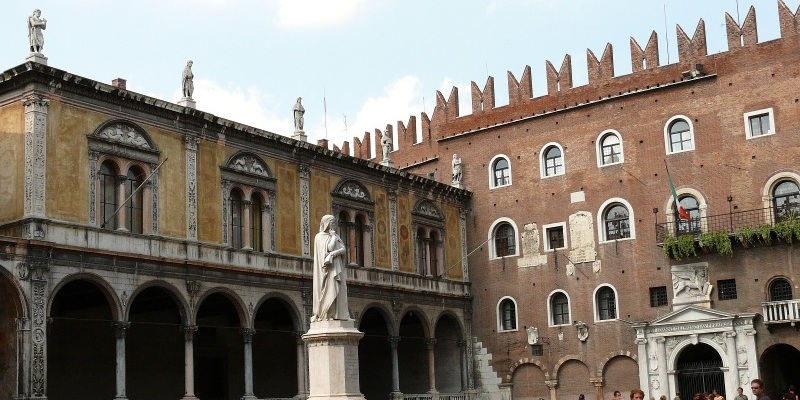Also known as the loggia by Fra' Giocondo for erroneous attribution to the celebrated architect of Verona, it was erected in 1476-93 at the behest of the elders of the city of Verona, as venue for the meetings of the City Council (which was a formal institution, because Venetian rule prevented any real form of autonomy).
In the nineteenth century the loggia was temporarily used as a civic art gallery and, in order to adapt better to this function, in 1820-38 and in 1870-74 underwent heavy renovations that altered the interior (floors, ceilings and painted decorations were redone), while the building was filled with commemorative medallions and busts of characters from Verona (the Protomoteca, established in 1810, consists of 110 graven images, now preserved in the Civic Library).
The facade is the work of Veronese humanist artists, while the decorative painting that covered the entire surface (the current one is the result of the intervention of 1870) by masters of Como. It has a porch with eight round arches; at the first floor there are four large mullioned windows (pediments and carved pilasters).
On top of the building are statues of famous personalities of the Roman Verona (Catullus , Plinius, Emilio Macro, Vitruvius , and Cornelius Nepos), by Alberto da Milano.
Inside the rooms of the loggia are kept some paintings commissioned by the Council in the sixteenth century. Other paintings of the 1500 and 1600 were transferred to Palazzo Barbieri or were destroyed. The painting Pomponio Triumphant by Giambettino Cignaroli dates back to the mid eighteenth century.
The Loggia of the Council is currently the seat of the Provincial Council and hosts meetings and cultural events.
On the arc that joins the loggia to the House of Mercy (rebuilt in 1490 on Scaligeri's residences) is a statue of Girolamo Fracastoro (great physician, astronomer and poet of Verona) carved in 1559 by Danese Cattaneo.
Are you a local? What do you think about Council Lodge (or Fra 'Giocondo)?
Login to suggest it!


